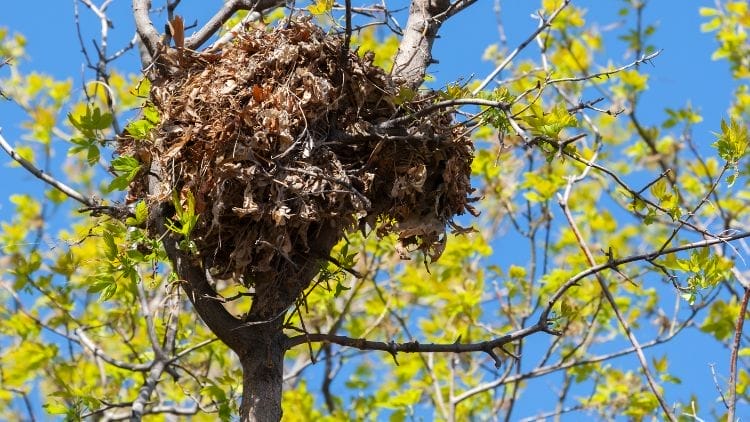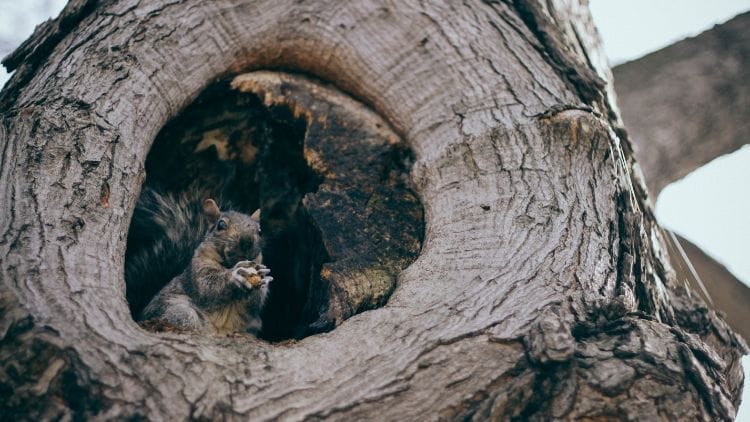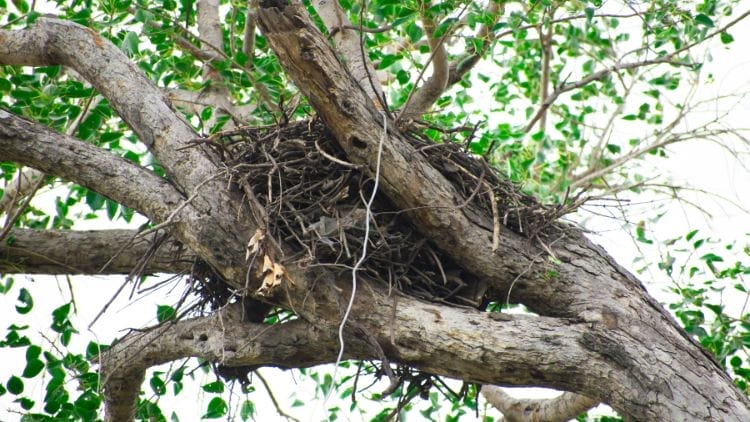A squirrel nest, also known as a drey, is a structure built by squirrels as a place to rest, shelter, and raise their young.
If you are interested in learning Squirrel’s info about Types of Squirrels And Common Species then click here.
These nests are typically made of twigs, leaves, moss, and other natural materials, and they are often located high in trees. Squirrels construct their nests in the fork of branches or within tree hollows, using their dexterous paws to weave and shape the materials into a cozy and secure home.
Nests provide protection from predators, harsh weather, and other environmental factors, allowing squirrels to thrive in various habitats.
Eastern Gray Squirrels, Red Squirrels, and Northern and Southern Flying Squirrels all make dreys.
In this article you gonna learn about the squirrel nest, Where do squirrels nest?
What does a squirrel’s drey look like? Different Kind of Nest, How is a squirrel leaf nest constructed? Dreys can be confused with bird nests.
Here are our recommendations on where, when, and how to locate them.
Where do squirrels nest?

Squirrels are highly adaptable creatures found in a variety of habitats, from urban parks to dense forests. They typically nest in trees, constructing their nests high above the ground for safety from predators and the elements. Some common locations for squirrel nests include:
- Tree Hollows: Squirrels often utilize natural tree hollows as ready-made shelters. These hollows provide excellent protection and insulation for raising their young.
- Leaf Nests (Dreys): Squirrels frequently build leaf nests, also known as dreys, in the branches of trees. These nests are constructed from twigs, leaves, moss, and other materials, forming a cozy and secure home.
- Attics and Buildings: In urban environments, squirrels may nest in attics, chimneys, or other sheltered areas of buildings. They can cause damage to property in their search for nesting sites.
- Underground Burrows: Some squirrel species, such as ground squirrels, dig burrows underground for nesting and hibernation. These burrows provide protection from predators and extreme weather conditions.
- Nest Boxes: In areas where natural nesting sites are scarce, people may install nest boxes or squirrel houses to provide additional shelter for squirrels. These artificial structures mimic the natural environment and can help support local squirrel populations.
What does a squirrel’s drey look like?

A squirrel’s drey is essentially its nest, constructed from twigs, leaves, moss, and other materials.
It’s typically round and compact, resembling a ball of foliage nestled within the branches of a tree. The interior is lined with softer materials like grass, feathers, or fur to provide warmth and comfort.
Dreys are often built high up in trees, providing shelter and protection for squirrels from predators and the elements. They can vary in size depending on the species of squirrel and the available materials in their environment.
Different Kinds of Nest
While the drey is the most common type of squirrel nest, there are other variations that different squirrel species might utilize. Here are a few different Kind of squirrel nests.
Eastern Gray Squirrel Nests

Eastern gray squirrels, like many squirrel species, build their nests, or dreys, high up in trees. These dreys are typically constructed in the forks of branches or against the trunk, providing stability and protection. They’re made from a combination of materials like twigs, leaves, moss, and sometimes even shreds of bark.
The outer structure of a gray squirrel’s drey often looks like a rounded mass of interwoven twigs and leaves, camouflaged to blend in with the surrounding foliage. Despite their seemingly delicate appearance, these nests are quite sturdy and can withstand various weather conditions.
Inside, the drey is lined with softer materials like grass, fur, feathers, or other insulating materials to provide warmth and comfort for the squirrel. The interior is cozy and snug, offering a safe haven for resting, sleeping, and raising their young.
Eastern gray squirrels may also build multiple dreys within their territory, using them for different purposes or as emergency shelters if needed. Overall, their nests are impressive examples of natural architecture, perfectly adapted to their arboreal lifestyle.
Other Squirrel Nests

Squirrels are resourceful creatures, and different species build nests suited to their specific habitats and needs. Here are some examples of squirrel nests.
Red Squirrel (Sciurus vulgaris): Red squirrels often construct large, round nests called “dreys” high up in coniferous trees. These dreys are made from twigs, leaves, moss, and grass, and they are usually located near the tree trunk for added stability. Red squirrels may also build smaller, temporary nests called “forms” in dense foliage.
Fox Squirrel (Sciurus niger): Fox squirrels build similar nests to gray squirrels but may use larger branches and materials due to their larger size. Their dreys are typically located in hardwood trees and may have multiple entrances for quick escape routes.
Flying Squirrel (Family: Sciuridae): Flying squirrels, unlike their counterparts, build nests in tree cavities or abandoned bird nests rather than constructing their own. They prefer secluded spots for their nests, providing safety from predators and the elements.
Ground Squirrels (Genus: Spermophilus): Ground squirrels, as their name suggests, create burrow systems rather than nests in trees. These burrows can be quite extensive, with multiple entrances and chambers for sleeping, storing food, and raising young.
Palm Squirrel (Funambulus spp.): Found in parts of Asia, palm squirrels construct nests high up in palm trees. These nests are made from palm leaves and other plant materials, offering a safe and elevated place for the squirrels to rest and raise their young.
How is a squirrel leaf nest constructed?
A squirrel leaf nest, also known as a drey, is constructed primarily from twigs, leaves, moss, and other available materials. Here’s a general overview of how squirrels build their leaf nests:
Location: Squirrels typically build their leaf nests high up in trees, often in the forks of branches or against the trunk. They choose locations that provide stability, protection from predators, and good visibility of their surroundings.
Gathering Materials: Squirrels collect materials for their nests from their surrounding environment. They gather twigs, small branches, leaves, moss, grass, and any other suitable items they can find.
Construction: The squirrel starts by weaving together a framework of twigs and small branches to form the outer structure of the nest. They interlace these materials to create a sturdy base.
Lining: Once the framework is in place, the squirrel lines the interior of the nest with softer materials like leaves, grass, moss, and even fur or feathers. This lining provides insulation and comfort for the squirrel, especially during colder weather.
Shaping: As the squirrel adds more materials, they shape the nest into a rounded or oval structure. They continually adjust and compact the materials to create a snug and secure nest.
Finishing Touches: Some squirrels may add additional layers of leaves or twigs to the outer surface of the nest for extra insulation and camouflage.
They may also incorporate other materials found in their environment, depending on availability and preference.
Maintenance: Squirrels regularly maintain and repair their nests as needed, especially after storms or other disturbances. They may add fresh materials or make structural adjustments to ensure the nest remains sturdy and secure.
Throughout the construction process, squirrels use their dexterous paws and teeth to manipulate and arrange the materials into the desired shape. The end result is a cozy and well-insulated shelter that provides protection from the elements and serves as a safe haven for the squirrels to rest, sleep, and raise their young.
Squirrel Vacation Homes
“Squirrel vacation homes” is a playful way of referring to squirrel dreys or nests, the cozy shelters that squirrels build high up in trees.
These structures serve as essential refuges for squirrels, providing them with protection from the elements and predators, as well as a comfortable place to rest and raise their young.
While the term “vacation homes” might evoke images of leisure and relaxation, squirrel dreys are vital components of their daily lives, serving as their primary residences throughout the year.
These nests are meticulously constructed from twigs, leaves, moss, and other materials, showcasing the resourcefulness and adaptability of these industrious rodents.
So, while they may not be vacationing in the traditional sense, squirrels certainly enjoy the comfort and security of their elevated abodes amidst the bustling canopy of trees.
A Squirrel Nest Timeline
The construction of a squirrel nest, or drey, follows a timeline dictated by the squirrels’ behavior, environmental factors, and the availability of resources. Typically, the process can be broken down into several stages:
Initially, squirrels begin scouting for suitable nesting sites, usually in late winter or early spring, when mating season approaches. They select locations high up in trees, favoring sturdy branches, forks, or hollows that provide stability and protection from predators.
As spring progresses and temperatures rise, squirrels gather materials for their nests. They diligently collect twigs, leaves, moss, grass, and other available vegetation, carrying them back to the chosen nesting site in their mouths or using their agile paws.
With the collected materials, squirrels start constructing the framework of the nest. They interweave twigs and branches to form a sturdy base, gradually shaping it into a rounded or oval structure. This process requires precision and dexterity, as squirrels carefully arrange and compact the materials to ensure stability.
Once the framework is established, squirrels line the interior of the nest with softer materials like leaves, moss, grass, and even fur or feathers. This lining provides insulation and comfort, creating a cozy environment for resting, sleeping, and raising young.
Throughout the nesting season, squirrels continuously maintain and repair their nests as needed. They may add fresh materials, reinforce weak spots, or make structural adjustments to ensure the nest remains sturdy and secure.
By late spring or early summer, squirrel nests are fully constructed and occupied. Squirrels may use their nests year-round for shelter, especially during harsh weather conditions, but they are particularly important during the breeding season for raising their young.
Overall, the construction of a squirrel nest is a meticulous and ongoing process, reflecting the squirrels’ resourcefulness and adaptability as they create a safe haven amidst the treetops.
Dreys can be confused with bird nests
Yes, that’s correct! Squirrel dreys, especially when observed from a distance or in certain lighting conditions, can sometimes be mistaken for bird nests.
This confusion is understandable because both structures are often built in trees and can have a similar rounded shape.
Here are a few factors that can contribute to the confusion between squirrel dreys and bird nests:
Location: Both squirrels and birds may choose similar locations within trees to build their nests, such as in the forks of branches or against the trunk. This proximity can make it challenging to distinguish between the two types of nests, especially from a distance.
Materials: While squirrels primarily use twigs, leaves, moss, and grass to construct their dreys, birds may also incorporate similar materials into their nests. Depending on the species of bird, their nests may have a similar appearance to squirrel dreys, especially if they use twigs and leaves as building materials.
Size and Shape: Some bird species build large, bulky nests that can resemble squirrel dreys in size and shape. For example, the nests of certain raptors or large songbirds may appear similar to squirrel dreys when viewed from a distance.
Camouflage: Both squirrel dreys and bird nests are often camouflaged to blend in with their surroundings, making them less conspicuous to predators.
This camouflage can further contribute to the difficulty of distinguishing between the two types of nests.
Despite these similarities, there are some key differences between squirrel dreys and bird nests that can help differentiate between them upon closer inspection. For example, bird nests often have a cup-like shape and may contain feathers or other materials not typically found in squirrel dreys.
Additionally, the presence of eggs or chicks can indicate a bird nest, while squirrel dreys are typically used solely by squirrels.
Where and when to see squirrels and their dreys?
Squirrels and their dreys can be observed in various habitats, primarily wooded areas, parks, gardens, and urban environments where trees are abundant.
The best time to see squirrels and their dreys depends on factors such as the season and time of day.
During spring and summer, when squirrels are active foraging for food and preparing for breeding, look for their dreys high up in trees, particularly in the early morning or late afternoon.
In the fall, squirrels are busy gathering and storing food for the upcoming winter months, making them more visible as they scurry about collecting nuts and seeds. Winter provides another opportunity to spot dreys amidst the bare branches, as squirrels may spend more time in their nests to stay warm during colder weather.
Urban areas also host squirrel populations, with parks and green spaces serving as common habitats. When observing squirrels and their dreys, patience and observation are key.
Look and listen for signs of squirrel activity, such as rustling leaves or chirping sounds, and use binoculars to spot dreys high up in trees. Always remember to respect wildlife and their habitats by observing from a distance and avoiding disturbances.
In conclusion,
Squirrel nests, or dreys, play a crucial role in the lives of these industrious rodents. From their meticulous construction to their strategic placement high up in trees, squirrel nests provide essential shelter and protection for squirrels throughout the year.
Constructed primarily from twigs, leaves, moss, and grass, these nests showcase the resourcefulness and adaptability of squirrels as they create cozy havens amidst the bustling canopy of trees.
Understanding the importance of squirrel nests helps us appreciate the intricate interactions between wildlife and their habitats, highlighting the need for conservation efforts to preserve these vital ecosystems.
As we continue to learn more about squirrel behavior and ecology, we deepen our appreciation for these remarkable creatures and the remarkable nests they call home.
FAQ
How do you save a squirrel?
If you encounter a squirrel in distress, the best course of action is to contact local wildlife rehabilitation centers or animal control authorities for guidance.
Attempting to handle a squirrel yourself can be risky for both you and the animal, as they may bite or scratch when frightened. Provide the squirrel with a quiet, safe space away from predators and traffic while waiting for assistance to arrive.
Should I remove the squirrel nest?
It’s generally not recommended to remove a squirrel nest unless absolutely necessary. Squirrel nests, or dreys, are vital shelters for squirrels, providing them with protection from the elements and predators.
Removing a nest can disrupt the squirrels’ habitat and potentially harm any occupants, especially during the breeding season.
If you believe a nest poses a safety hazard or needs to be relocated for valid reasons, it’s best to consult with local wildlife authorities for guidance on how to proceed.
What do you put in a squirrel nest?
Squirrel nests, or dreys, are typically constructed from natural materials found in their environment, such as twigs, leaves, moss, and grass.
If you’re providing materials for a squirrel nest, you can offer small, clean twigs and branches, dry leaves, and soft nesting materials like untreated cotton or wool.
Avoid using materials treated with chemicals or pesticides, as these can be harmful to squirrels. Providing nesting materials can be a helpful way to support local squirrel populations, especially in urban or suburban areas where natural nesting sites may be scarce.


You May Also Read